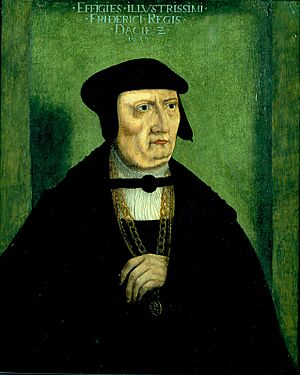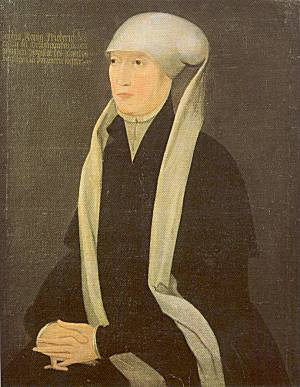Frederick I of Denmark facts for kids
Quick facts for kids Frederick I |
|
|---|---|

Portrait of Frederick attributed to Jacob Binck, 1539. No portraits of the King painted during his lifetime are known.
|
|
| King of Denmark (more...) | |
| Reign | 1523 – 10 April 1533 |
| Coronation | 7 August 1524 Copenhagen Cathedral |
| Predecessor | Christian II |
| Successor | Christian III |
| King of Norway | |
| Reign | 1524 – 10 April 1533 |
| Predecessor | Christian I |
| Successor | Christian III |
| Duke of Schleswig-Holstein | |
| Reign | 1482 – 10 April 1533 |
| Predecessor | Christian II |
| Successor | Christian III |
| Co-duke | John (until 1490) |
| Born | 7 October 1471 Haderslevhus |
| Died | 10 April 1533 (aged 61) Gottorf Castle |
| Burial | Schleswig Cathedral |
| Spouse |
Anna of Brandenburg
(m. 1502; died 1514)Sophie of Pomerania
(m. 1518) |
| Issue among others... |
Christian III of Denmark Dorothea, Duchess of Prussia John II, Duke of Schleswig-Holstein-Haderslev Elizabeth, Duchess of Mecklenburg Adolf, Duke of Holstein-Gottorp Dorothea, Duchess of Mecklenburg Frederick, Bishop of Hildesheim and Schleswig |
| House | Oldenburg |
| Father | Christian I of Denmark |
| Mother | Dorothea of Brandenburg |
| Religion | Catholicism |
Frederick I (born October 7, 1471 – died April 10, 1533) was a powerful king who ruled both Denmark and Norway. He was the last king in these countries to follow the Catholic Church. After his time, future kings chose to follow Lutheranism, which was a new form of Christianity.
Frederick never actually visited Norway during his time as king. He was known for starting a tradition where Danish kings would alternate between the names Christian and Frederick.
Contents
Early Life and Becoming a Duke
Frederick was the younger son of Christian I of Denmark, who was the first king from the Oldenburg family. His mother was Dorothea of Brandenburg. When his father died in 1482, young Frederick became a co-duke of Schleswig and Holstein. He shared this role with his older brother, King John. In 1490, when Frederick became an adult, the two duchies were divided between the brothers.
The Battle of Hemmingstedt
In the year 1500, Frederick convinced his brother, King John, to try and conquer an area called Dithmarschen. They gathered a very large army, including soldiers from the Kalmar Union (a union of Nordic countries) and many German mercenaries. However, this military trip ended very badly. In the Battle of Hemmingstedt, many knights from Schleswig and Holstein lost their lives.
Becoming King of Denmark and Norway
After his brother, King John, passed away, some nobles in Denmark offered Frederick the throne in 1513. But Frederick thought that most of the Danish nobles would stay loyal to his nephew, Christian II.
However, in 1523, Christian II was forced to give up his crown by some nobles who were against him. So, Frederick became the King of Denmark in 1523. He was then chosen as the King of Norway in 1524. It's interesting to note that Frederick might not have even learned to speak Danish. He spent most of his time at Gottorf Castle in the city of Schleswig.
Facing Rebellions
During 1524 and 1525, King Frederick had to deal with rebellions from farmers in different parts of his kingdom. These farmers wanted Christian II to be king again. The biggest rebellion happened in 1525 when Søren Norby, a governor from Gotland, attacked Blekinge. He gathered 8,000 men and surrounded Kärnan, a castle in Helsingborg. Frederick's general, Johann Rantzau, moved his army to Scania and strongly defeated the farmers in April and May of 1525.
Religious Changes and the Reformation
Frederick played an important part in how Lutheranism spread across Denmark. When he became king, he promised to protect the Catholic Church in Denmark. Because of this role, he said he had the right to choose bishops for the Catholic areas in the country.
Unlike Christian II, who didn't like Protestant ideas, Frederick was more open to them. For example, he ordered that Catholics and Lutherans should share the same churches. He also encouraged the first time the Bible was printed in the Danish language. In 1526, when a Lutheran leader named Hans Tausen was about to be arrested for his beliefs, Frederick made him his personal chaplain. This gave Tausen special protection.
Starting in 1527, Frederick allowed the closing of some Franciscan churches and monasteries in 28 Danish cities. He used the public's dislike for some parts of the Catholic leadership and nobility to reduce their power.
Capturing Christian II
During his time as king, Frederick was very skilled at preventing a full-scale war between Catholics and Protestants. In 1532, he successfully captured Christian II, who had tried to invade Norway. This helped Frederick secure his position as king of Norway.
Frederick died on April 10, 1533, at Gottorp Castle. He was 61 years old and was buried in Schleswig Cathedral. After Frederick's death, the disagreements between Catholics and Protestants grew much stronger. This eventually led to a big conflict known as the Count's Feud.
Family and Children
On April 10, 1502, Frederick married Anna of Brandenburg (1487–1514). She was the daughter of John Cicero, Elector of Brandenburg. They had two children:
- Christian III, King of Denmark and Norway (born August 12, 1503 – died January 1, 1559)
- Dorothea of Denmark (born August 1, 1504 – died April 11, 1547), who married Albert, Duke of Prussia.
Frederick's first wife, Anna, died on May 5, 1514, when she was 26 years old. Four years later, on October 9, 1518, Frederick married Sophie of Pomerania (1498–1568) in Kiel. She was 20 years old and the daughter of Bogislaw "the Great", Duke of Pomerania. Sophie and Frederick had six children:
- John II of Denmark, Duke of Schleswig-Holstein-Haderslev (born June 28, 1521 – died October 2, 1580)
- Elizabeth of Denmark (born October 14, 1524 – died October 15, 1586), who married two times.
- Adolf of Denmark, Duke of Holstein-Gottorp (born January 25, 1526 – died October 1, 1586)
- Anna of Denmark (born 1527 – died June 4, 1535)
- Dorothea of Denmark (born 1528 – died November 11, 1575), who married Christopher, Duke of Mecklenburg-Gadebusch.
- Frederick of Denmark (born April 13, 1532 – died October 27, 1556), who became a Prince-Bishop.
See also
 In Spanish: Federico I de Dinamarca para niños
In Spanish: Federico I de Dinamarca para niños



